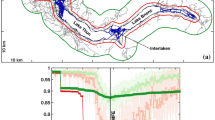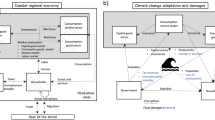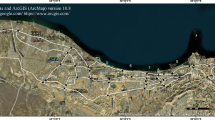Abstract
As extreme weather events enhanced by climate change pose challenges to the resilience of critical infrastructure, the ability to handle disruptions, avoid tipping points, adapt and transform in crises becomes essential. Despite advances in resilience research, there is a need to improve empirical evidence and mathematical models to quantify the systems’ adaptive capabilities to extreme climate-related phenomena, such as floods. This research fills this gap by integrating an agent-based multimodal traffic functional model with a compound failure model to provide valuable insights into adaptation patterns (that is, mode shift and route switching) and risk mitigation in response to flood-related disruptions. The proposed modelling approach not only quantifies the recovery and adaptive capacity against failures, going beyond traditional resilience analyses, but also unveils the key factors that drive adaptation of transportation to flood-induced disasters. These factors include variations in trip demand and network density, which together reveal a universal law of mode shift. The study provides valuable insights into the design of resilient and sustainable critical infrastructure systems, such as transportation, energy and communication systems capable of withstanding severe flood events while maintaining their functionality.
This is a preview of subscription content, access via your institution
Access options
Access Nature and 54 other Nature Portfolio journals
Get Nature+, our best-value online-access subscription
27,99 € / 30 days
cancel any time
Subscribe to this journal
Receive 12 digital issues and online access to articles
118,99 € per year
only 9,92 € per issue
Buy this article
- Purchase on SpringerLink
- Instant access to full article PDF
Prices may be subject to local taxes which are calculated during checkout





Similar content being viewed by others
Data availability
The Nanjing multimodal transport simulation model is available via GitHub at https://github.com/ChunhongLi8/adaptiveCapacityOfUrbanTransportNetwork. The Hamburg multimodal transport simulation model is available via GitHub at https://github.com/matsim-scenarios/matsim-hamburg. The LA multimodal transport simulation model is available via GitHub at https://github.com/matsim-scenarios/matsim-los-angeles. Flood hazard data for a 100-year return period for Nanjing and Hamburg are available from the Joint Research Centre of European Commission61. Flood hazard data for a 100-year return period for LA is available via Zenodo at https://doi.org/10.5281/zenodo.6965044 (ref. 63). The human mobility dataset for LA scenario validation is available via GitHub at https://github.com/GeoDS/COVID19USFlows. For contractual and privacy reasons, we cannot make the vehicle mobility dataset for Nanjing available. One can contact Amap to try to get access to the Nanjing vehicle mobility dataset.
Code availability
The implementation of this work is available via GitHub at https://github.com/ChunhongLi8/adaptiveCapacityOfUrbanTransportNetwork.
References
Tellman, B. et al. Satellite imaging reveals increased proportion of population exposed to floods. Nature 596, 80–86 (2021).
Llasat, M. C. Spain’s flash floods reveal a desperate need for improved mitigation efforts. Nature 635, 787 (2024).
Zhu, Y. et al. Burden of infant mortality associated with flood in 37 African countries. Nat. Commun. 15, 10171 (2024).
Wang, W., Yang, S., Stanley, H. E. & Gao, J. Local floods induce large-scale abrupt failures of road networks. Nat. Commun. 10, 2114 (2019).
Koks, E. E. et al. A global multi-hazard risk analysis of road and railway infrastructure assets. Nat. Commun. 10, 2677 (2019).
Merz, B. et al. Causes, impacts and patterns of disastrous river floods. Nat. Rev. Earth Environ. 2, 592–609 (2021).
Wang, W. et al. An integrated approach for assessing the impact of large‐scale future floods on a highway transport system. Risk Anal. 40, 1780–1794 (2020).
Balaian, S. K., Sanders, B. F. & Abdolhosseini Qomi, M. J. How urban form impacts flooding. Nat. Commun. 15, 6911 (2024).
Kreibich, H. et al. The challenge of unprecedented floods and droughts in risk management. Nature 608, 80–86 (2022).
Transforming Our World: The 2030 Agenda for Sustainable Development (United Nations, 2015).
Logan, T. M., Aven, T., Guikema, S. D. & Flage, R. Risk science offers an integrated approach to resilience. Nat. Sustain 5, 741–748 (2022).
Reyers, B., Moore, M.-L., Haider, L. J. & Schlüter, M. The contributions of resilience to reshaping sustainable development. Nat. Sustain 5, 657–664 (2022).
Holling, C. S. Resilience and stability of ecological systems. Annu. Rev. Ecol. Syst. 4, 1–23 (1973).
Thacker, S. et al. Infrastructure for sustainable development. Nat. Sustain 2, 324–331 (2019).
Rockström, J. et al. Shaping a resilient future in response to COVID-19. Nat. Sustain 6, 897–907 (2023).
Goodwin, S., Olazabal, M., Castro, A. J. & Pascual, U. Global mapping of urban nature-based solutions for climate change adaptation. Nat. Sustain 6, 458–469 (2023).
Zhong, L., Lopez, D., Pei, S. & Gao, J. Healthcare system resilience and adaptability to pandemic disruptions in the United States. Nat. Med. 30, 2311–2319 (2024).
Liu, X. et al. Network resilience. Phys. Rep. 971, 1–108 (2022).
Kasmalkar, I. G. et al. When floods hit the road: resilience to flood-related traffic disruption in the San Francisco Bay Area and beyond. Sci. Adv. 6, eaba2423 (2020).
Zhang, L. et al. Scale-free resilience of real traffic jams. Proc. Natl Acad. Sci. USA 116, 8673–8678 (2019).
Ganin, A. A. et al. Resilience and efficiency in transportation networks. Sci. Adv. 3, e1701079 (2017).
Luppi, A. I. et al. Quantifying synergy and redundancy between networks. Cell Rep. Phys. Sci. 5, 101713 (2024).
He, Y. et al. Mobility and Resilience: A Global Assessment of Flood Impacts on Road Transportation Networks (The World Bank, 2022).
Sun, J., Chow, A. C. & Madanat, S. M. Multimodal transportation system protection against sea level rise. Transp. Res. D Transp. Environ. 88, 102568 (2020).
Axhausen, K. W., Horni, A. & Nagel, K. The Multi-Agent Transport Simulation MATSim (Ubiquity, 2016).
Zhang, Y. et al. Hydrometeorological analysis and remote sensing of extremes: was the July 2012 Beijing flood event detectable and predictable by global satellite observing and global weather modeling systems? J. Hydrometeorol. 16, 381–395 (2015).
Facchinei, F. & Kanzow, C. Generalized Nash equilibrium problems. Ann. Oper. Res. 175, 177–211 (2010).
Solé-Ribalta, A., Gómez, S. & Arenas, A. Congestion induced by the structure of multiplex networks. Phys. Rev. Lett. 116, 108701 (2016).
Vij, A., Carrel, A. & Walker, J. L. Incorporating the influence of latent modal preferences on travel mode choice behavior. Transp. Res. Part A Policy Pract. 54, 164–178 (2013).
Brög, W., Erl, E., Ker, I., Ryle, J. & Wall, R. Evaluation of voluntary travel behaviour change: experiences from three continents. Transp. Policy 16, 281–292 (2009).
Nash, J. F. Non-cooperative games. Ann. Math. 54, 286–295 (1951).
Wardrop, J. G. Road paper. Some theoretical aspects of road traffic research. Proc. Inst. Civ. Eng. 1, 325–362 (1952).
Çolak, S., Lima, A. & González, M. C. Understanding congested travel in urban areas. Nature Commun. 7, 10793 (2016).
Zhang, S., Hua, L. & Yu, B. Peak-easing strategies for urban subway operations in the context of COVID-19 epidemic. Transp. Res. E Logist. Transp. Rev. 161, 102724 (2022).
Bagloee, S. A., Johansson, K. H. & Asadi, M. A hybrid machine-learning and optimization method for contraflow design in post-disaster cases and traffic management scenarios. Expert Syst. Appl. 124, 67–81 (2019).
Bruneau, M. et al. A framework to quantitatively assess and enhance the seismic resilience of communities. Earthq. Spectra 19, 733–752 (2003).
Xu, Z. & Chopra, S. S. Interconnectedness enhances network resilience of multimodal public transportation systems for safe-to-fail urban mobility. Nat. Commun. 14, 4291 (2023).
Çakar, K. Tourophobia: fear of travel resulting from man-made or natural disasters. Tour. Rev. 76, 103–124 (2021).
Li, W., Wang, Q., Liu, Y., Small, M. L. & Gao, J. A spatiotemporal decay model of human mobility when facing large-scale crises. Proc. Natl Acad. Sci. USA 119, e2203042119 (2022).
Hong, B., Bonczak, B. J., Gupta, A. & Kontokosta, C. E. Measuring inequality in community resilience to natural disasters using large-scale mobility data. Nat. Commun. 12, 1870 (2021).
Anderson, S. A. & Weir, J. T. The role of divergent ecological adaptation during allopatric speciation in vertebrates. Science 378, 1214–1218 (2022).
Nowak, M. A. & Sigmund, K. Evolutionary dynamics of biological games. Science 303, 793–799 (2004).
Majdandzic, A. et al. Multiple tipping points and optimal repairing in interacting networks. Nat. Commun. 7, 10850 (2016).
An open database of political administrative boundaries. geoBoundaries https://www.geoboundaries.org/ (2020).
Sienkiewicz, J. & Hołyst, J. A. Statistical analysis of 22 public transport networks in Poland. Phys. Rev. E Stat. Nonlin. Soft Matter Phys. 72, 046127 (2005).
Dynamic traffic service. NAVIINFO https://en.navinfo.com/dynamic-traffic-service (2020).
Poletti, F., Bösch, P. M., Ciari, F. & Axhausen, K. W. Public transit route mapping for large-scale multimodal networks. ISPRS Int. J. Geoinf. 6, 268 (2017).
Zipf, G. K. The P 1 P 2/D hypothesis: on the intercity movement of persons. Am. Sociol. Rev. 11, 677–686 (1946).
Simini, F., González, M. C., Maritan, A. & Barabási, A.-L. A universal model for mobility and migration patterns. Nature 484, 96–100 (2012).
Yan, X.-Y., Wang, W.-X., Gao, Z.-Y. & Lai, Y.-C. Universal model of individual and population mobility on diverse spatial scales. Nat. Commun. 8, 1639 (2017).
Amap open platform. Amap https://lbs.amap.com/ (2020).
Trip generation indicator study group. Trip Generation Manual (in Chinese) (China Architecture and Building, 2009).
Barbosa, H. et al. Human mobility: models and applications. Phys. Rep. 734, 1–74 (2018).
Gonzalez, M. C., Hidalgo, C. A. & Barabasi, A.-L. Understanding individual human mobility patterns. Nature 453, 779–782 (2008).
Nguyen, J., Powers, S. T., Urquhart, N., Farrenkopf, T. & Guckert, M. An overview of agent-based traffic simulators. Transp. Res. Interdiscip. Perspect. 12, 100486 (2021).
Schlenther, T. et al. Simulation-based investigation of transport scenarios for Hamburg. Procedia Comput. Sci. 201, 587–593 (2022).
Rodier, C., Chai, H. & Kaddoura, I. Simulating the effects of shared automated vehicles and benefits to low-income communities in Los Angeles (UC Davis: National Center for Sustainable Transportation, 2022); https://doi.org/10.7922/G2XW4H45
Rodier, C., Kaddoura, I. & Chai, H. How can automated vehicles increase access to marginalized populations and reduce congestion, vehicle miles traveled, and greenhouse gas emissions? A case study in the city of Los Angeles (UC Davis: National Center for Sustainable Transportation, 2022); https://doi.org/10.7922/G2SB441H
Amap smart traffic. Amap https://jiaotong.amap.com/#/ (2024).
Kang, Y. et al. Multiscale dynamic human mobility flow dataset in the U.S. during the COVID-19 epidemic. Sci. Data 7, 390 (2020).
Dottori, F. et al. Flood hazard map of the World - 100-year return period. European Commission, Joint Research Centre (JRC) http://data.europa.eu/89h/jrc-floods-floodmapgl_rp100y-tif (2016).
Sanders, B. F. et al. Large and inequitable flood risks in Los Angeles, California. Nat. Sustain. 6, 47–57 (2023).
Schubert, J. et al. Los Angeles 100-year flood risk. Zenodo https://doi.org/10.5281/zenodo.6965044 (2022).
Acknowledgements
C.L., W.W., B.J., Z.L. and Z.G. are supported by the National Natural Science Foundation of China (grant nos. 72288101, 72242102, 72471031, W2411064, 72001018 and 72361137002), the Jiangsu Provincial Scientific Research Center of Applied Mathematics (grant no. BK20233002), Natural Science Foundation of Beijing, China (grant no. 9242012) and Guangdong Provincial Natural Science Foundation (grant no. 2023A1515010604). J.G. is supported by the National Science Foundation of the United States (grant no. 2047488) and by the Rensselaer-IBM AI Research Collaboration. A.S.-R. and J.B.-H. acknowledge financial support from the Ministry of Science and Innovation of Spain, through project no. PID2021-128966NB-I00. J.B.-H. acknowledges financial support from the Ramón y Cajal programme through grant no. RYC2020-030609-I. We sincerely thank L. Zhong, K. Huang, Z. Bai and J. Liu for insightful discussions.
Author information
Authors and Affiliations
Contributions
C.L., W.W., B.J. and J.G. conceived the project and designed the study. C.L., W.W., B.J. and J.G. performed the data analyses. C.L., W.W., A.S.-R., J.B.-H., B.J., Z.G. and J.G. wrote the first draft of the manuscript. C.L., W.W., A.S.-R., J.B.-H., B.J., Z.L., B.Y., Z.G. and J.G. contributed to interpreting the results and improving the manuscript.
Corresponding authors
Ethics declarations
Competing interests
The authors declare no competing interests.
Peer review
Peer review information
Nature Sustainability thanks Yu Han, Pu Wang and the other, anonymous, reviewer(s) for their contribution to the peer review of this work.
Additional information
Publisher’s note Springer Nature remains neutral with regard to jurisdictional claims in published maps and institutional affiliations.
Extended data
Extended Data Fig. 1 The driving factors of adaptability.
We utilize a set of controlled trials to explore the potential drivers for adaptive capacity. Passengers in the treatment group Fa must maintain the same travel routes and modes as in the baseline scenario. In contrast, passengers in the treatment group Fb are allowed to adjust their travel routes but not their modes in response to flood-induced disruptions. Meanwhile, passengers in the control group F have the flexibility to modify both their travel routes and modes without any restrictions. We then compare trips composition for each group and display trips flow with growing adaptability for Nanjing (T=3m) (a), Hamburg (T=4m) (b) and LA (T=0.3 m) (c).
Extended Data Fig. 2 The social dimension of adaptive capacity.
a-d Sankey diagrams display the way that travelers adapt to the adverse effect induced by floods (T = 0.3 m) in Hispanic, HP (a), Non-Hispanic Black, NHB (b), Non-Hispanic Asian, NHAS (c), and Non-Hispanic White, NHW (d). e-h In a similar vein, for travelers divided by household annual income quartiles, with the first quartile representing the poorest (e) and the fourth quartile representing the wealthiest (h). i-l For travelers holding distinct education attainments, including no education (i), below high school (j), completing high school (k), and associate/bachelor or higher (l). Numbers in brackets indicate adaptive capacity metric, κ, for each cluster (see Eq. (8) in Methods).
Extended Data Fig. 3 The model validation.
a-b We extracted and processed Nanjing’s empirical mobility datasets on a typical normal workday (July 18, 2024) and a stormy workday (July 11, 2024) from Amap, an online navigation provider. Panel (a) shows the comparison of cumulative density function (CDF) for travel time between the normal workday and the simulated baseline scenario. Same to panel (a), panel (b) depicts the comparison between the rainy workday (July 11, 2024) and simulated flooding scenario (T=6m). c-d We also compare the travel radius distribution for LA between simulation data and empirical human mobility data derived from SafeGraph, a ___location data service provider. Panel (c) compares the CDF of travel radius between the baseline model and a normal workday (Wednesday, February 27, 2019), while panel (d) compares the CDF of travel radius between the flooding model (T=0) and a stormy workday (Wednesday, March 6, 2019). In all panels, we present the Kolmogorov-Smirnov (KS) test results (*** indicates that the p-value is less than 0.001).
Supplementary information
Supplementary Information
Supplementary Notes 1–13, Figs. 1–33 and Tables 1–15.
Supplementary Video 1
Travel behaviour changes due to flooding.
Rights and permissions
Springer Nature or its licensor (e.g. a society or other partner) holds exclusive rights to this article under a publishing agreement with the author(s) or other rightsholder(s); author self-archiving of the accepted manuscript version of this article is solely governed by the terms of such publishing agreement and applicable law.
About this article
Cite this article
Li, C., Wang, W., Solé-Ribalta, A. et al. Adaptive capacity for multimodal transport network resilience to extreme floods. Nat Sustain (2025). https://doi.org/10.1038/s41893-025-01575-z
Received:
Accepted:
Published:
DOI: https://doi.org/10.1038/s41893-025-01575-z



